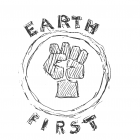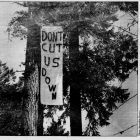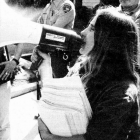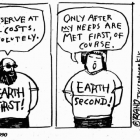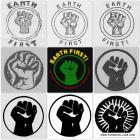Introducing Earth First!
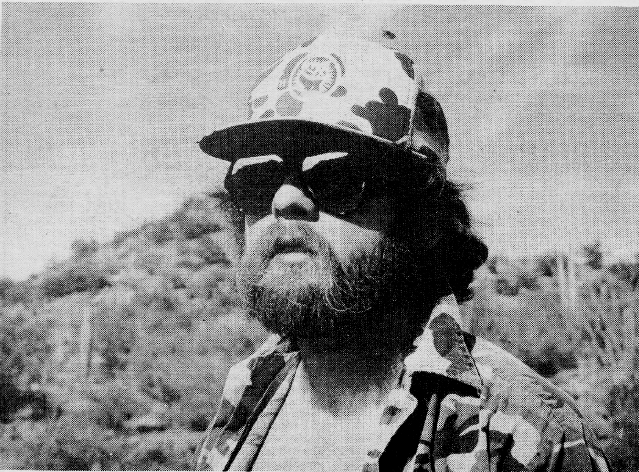
Dave Foreman’s image was used in a 1985 journal (Earth First! 5, no. 7) to advertise Earth First!’s merchandise, which included camouflage baseball caps
Dave Foreman’s image was used in a 1985 journal (Earth First! 5, no. 7) to advertise Earth First!’s merchandise, which included camouflage baseball caps
© Earth First!
The copyright holder reserves, or holds for their own use, all the rights provided by copyright law, such as distribution, performance, and creation of derivative works.
Earth First!, the best known of the so-called “radical environmental” groups, was founded in 1980 in the southwestern United States. Dave Foreman, who had been working for The Wilderness Society, was the most charismatic and well-connected of the new movement’s co-founders. He soon sent out a mimeographed announcement of the group, explaining that politics as usual—electoral politics and lobbying—had failed to significantly slow, let alone halt the destruction of the wilderness areas and a corresponding decline of the continent’s biodiversity.
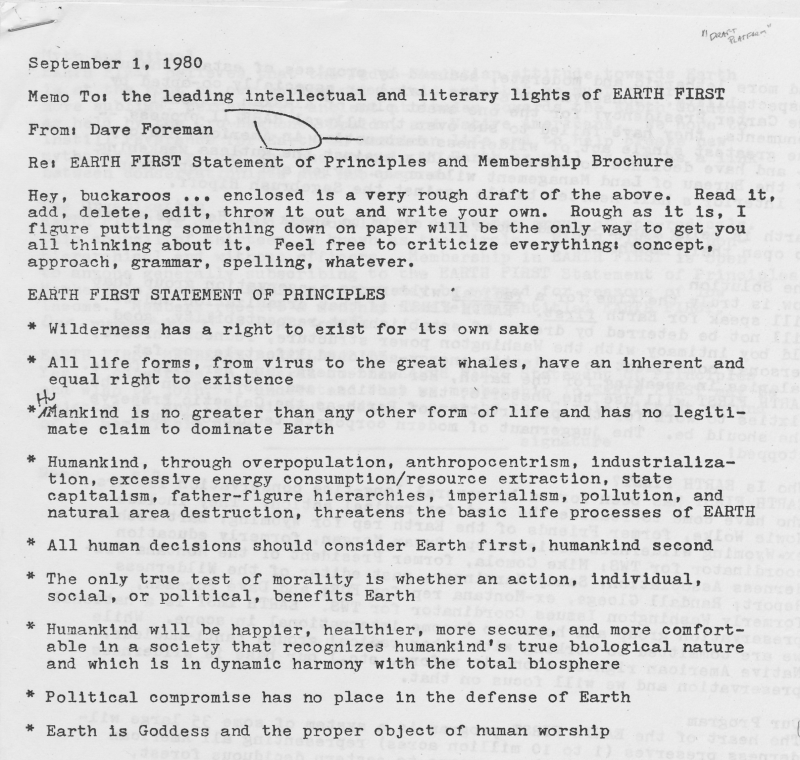
In the very first Earth First memo, founder Dave Foreman explains the conception and program of the then newly founded Earth First organization. Read the entire Statement of Principles and Membership Brochure here.
In the very first Earth First memo, founder Dave Foreman explains the conception and program of the then newly founded Earth First organization. Read the entire Statement of Principles and Membership Brochure here.
The copyright holder reserves, or holds for their own use, all the rights provided by copyright law, such as distribution, performance, and creation of derivative works.
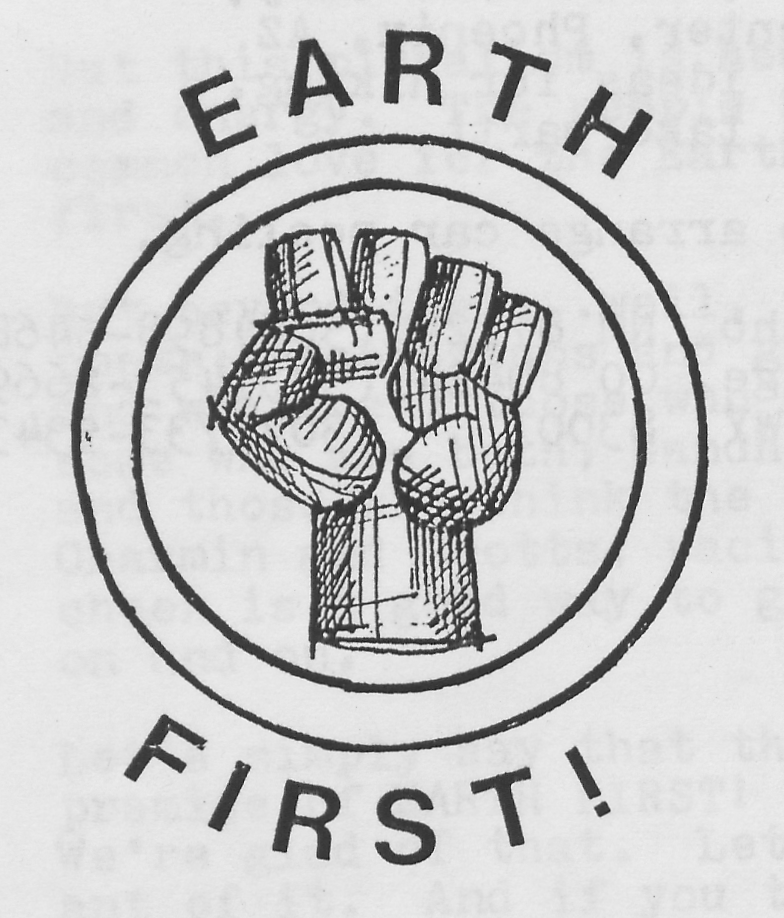
This first Earth First! logo with an added exclamation point, formulated in 1981 (see Earth First! 1, no. 3)
This first Earth First! logo with an added exclamation point, formulated in 1981 (see Earth First! 1, no. 3)
© Earth First!
The copyright holder reserves, or holds for their own use, all the rights provided by copyright law, such as distribution, performance, and creation of derivative works.
With the slogan, “No compromise in defense of mother earth!”—and punctuating their passion by putting an exclamation point at the end of their moniker Earth First!—Foreman and his comrades promoted the idea that every life form, and indeed every ecosystem, has intrinsic value and a right to live and flourish regardless of human interests. (In the parlance of environmental ethics this notion has been variously labeled as ecocentrism, biocentrism, and deep ecology.)
It was this ethical standpoint, combined with a view that democratic processes had broken down, weakened or were corrupted by corporate power and wealth, upon which Earth First!ers based their contention that extra-legal tactics in defense of threatened species and ecosystems were morally warranted. Soon, those drawn to the movement would put such convictions into practice, engaging in civil disobedience and sabotage as means to thwart environmentally destructive commercial enterprises and the governmental decisions that enabled them.
And before long, business leaders, politicians, law enforcement authorities, and many others would rise up to attack these activists, labeling them terrorists and working ardently to suppress their movement. The ensuing conflicts have been long, trenchant, wrenching, and sometimes violent.

Earth First!ers Diana Warren, Molly Campbell, Peter Swanson, William Smith, and Doug Norlen facing a bulldozer during the Kalmiopsis Wilderness blockade to save 150,000 acres of primeval forest. All were arrested, arraigned, and placed on probation with restraining orders issued against them. See Earth First! 3, no. 5.
Earth First!ers Diana Warren, Molly Campbell, Peter Swanson, William Smith, and Doug Norlen facing a bulldozer during the Kalmiopsis Wilderness blockade to save 150,000 acres of primeval forest. All were arrested, arraigned, and placed on probation with restraining orders issued against them. See Earth First! 3, no. 5.
Photograph by Frank Siles
The copyright holder reserves, or holds for their own use, all the rights provided by copyright law, such as distribution, performance, and creation of derivative works.
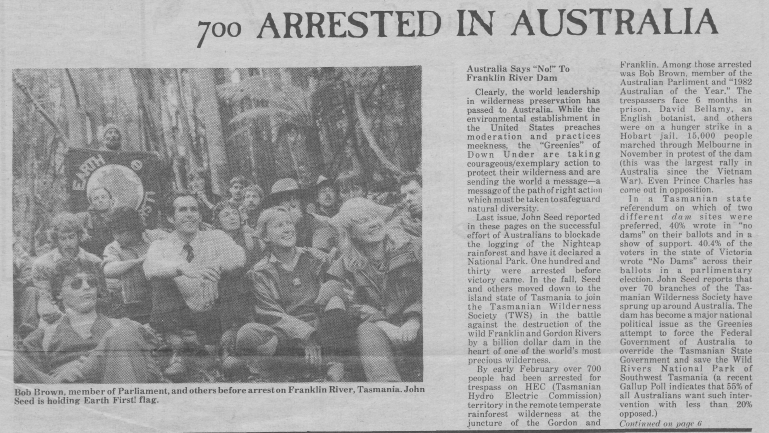
This article about the arrests of 700 Australian Earth First!ers protesting the damming of the Franklin River in Tasmania shows the spread of the movement and its values beyond the United States. See Earth First! 3, no. 3.
This article about the arrests of 700 Australian Earth First!ers protesting the damming of the Franklin River in Tasmania shows the spread of the movement and its values beyond the United States. See Earth First! 3, no. 3.
The copyright holder reserves, or holds for their own use, all the rights provided by copyright law, such as distribution, performance, and creation of derivative works.
Soon after Earth First!’s founding, its mimeographed announcement morphed into Earth First!: The Radical Environmental Journal, which is now available in full, here on the Environment & Society Portal. While much has been written about this movement and its influence on environmental politics in the United States and other countries, there is no better way—apart from having been present when these activists gather to play, plot strategy, or protest—to get a visceral feel for the movement than by perusing the journal. Yet the pages of the journal may be more intelligible with some background about the events that gave rise to the movement and an overview of some of the watershed moments in its history.
- Previous chapter
- Next chapter




